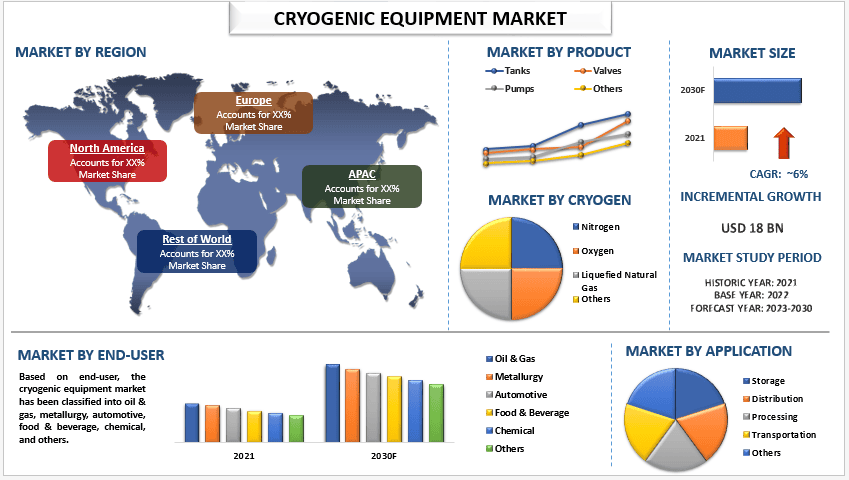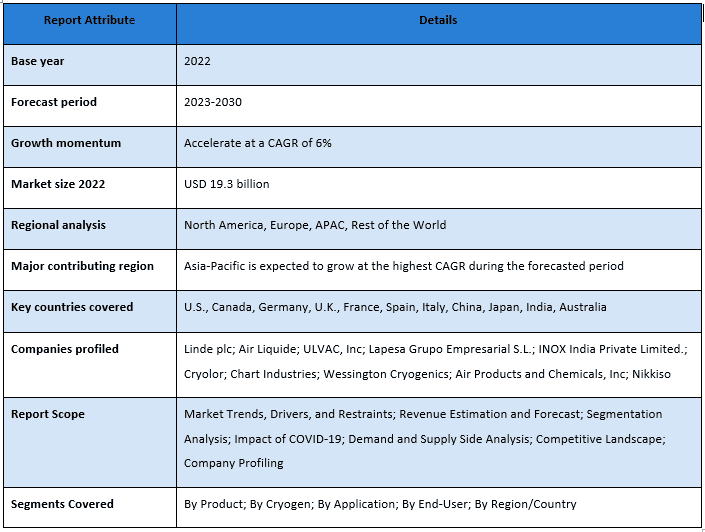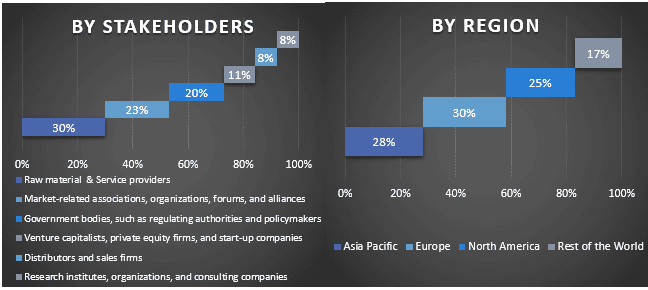Рынок криогенного оборудования: текущий анализ и прогноз (2023-2030 гг.)
Акцент на продукцию (резервуары, клапаны, насосы и другое); криоген (азот, кислород, сжиженный природный газ и другое); применение (хранение, распределение, обработка, транспортировка и другое); и конечные пользователи (нефтегазовая отрасль, металлургия, автомобилестроение, пищевая промышленность, химическая промышленность и другое); и регион/страна

Объем мирового рынка криогенного оборудования в 2022 году оценивался в 19,3 миллиарда долларов США, и ожидается, что в период с 2023 по 2030 год он будет расти со среднегодовым темпом роста в 6%. Криогенное оборудование определяется как оборудование, используемое в производстве, хранении, транспортировке и распределении криогенных жидкостей, которые представляют собой жидкости с температурой ниже -150°C. Криогенные жидкости включают газы, такие как жидкий азот, жидкий гелий и сжиженный природный газ. Криогенное оборудование используется в различных отраслях промышленности, включая здравоохранение, промышленное производство и научные исследования. Оно используется для различных целей, таких как охлаждение и замораживание, стерилизация и хранение термочувствительных материалов. Примеры криогенного оборудования включают криогенные резервуары, охлаждающие рубашки и генераторы жидкого азота. Факторы, такие как увеличение торговли СПГ и достижения в системах криогенного хранения энергии в сочетании с растущим спросом на чистые источники энергии. Крупные компании на рынке предлагают криогенное оборудование для различных целей. Например, в сентябре 2022 года президент Мурму открыл новый завод HAL по производству криогенных двигателей для ракет ISRO. Кроме того, в апреле 2023 года INOXCVA открыла крупнейшее в Индии предприятие по производству криогенного оборудования с возможностью изготовления более 20 000 метрических тонн в год оборудования из нержавеющей стали.
Linde plc; Air Liquide; ULVAC, Inc; Lapesa Grupo Empresarial S.L.; INOX India Private Limited.; Cryolor; Chart Industries; Wessington Cryogenics; Air Products and Chemicals, Inc; Nikkiso - вот некоторые из ключевых игроков на рынке. Эти игроки заключили несколько сделок по слияниям и поглощениям, а также партнерств, чтобы предоставлять клиентам высокотехнологичные и инновационные продукты/технологии.
Аналитическая информация, представленная в отчете
"Ожидается, что среди применений хранение будет расти со значительным среднегодовым темпом роста в течение прогнозируемого периода"
На основе применения рынок подразделяется на хранение, распределение, переработку, транспортировку и другие. Среди них ожидается, что хранение будет расти со значительным среднегодовым темпом роста в течение прогнозируемого периода. Это в основном связано с высоким уровнем использования вакцин для быстрой заморозки и сохранения биологических образцов, таких как человеческая плоть, ооциты и мышцы, что приводит к высокому спросу на продукт на рынке. Кроме того, выход мировых игроков на развивающиеся рынки способствует росту рынка. Например, в феврале 2023 года Azenta запустила Cryo Store Pico, новую автоматизированную систему криогенного хранения, разработанную для клинических и лабораторных применений.
"Ожидается, что среди конечных пользователей категория металлургии будет расти со значительным среднегодовым темпом роста в течение прогнозируемого периода"
На основе конечного пользователя рынок криогенного оборудования был классифицирован на нефть и газ, металлургию, автомобилестроение, продукты питания и напитки, химическую промышленность и другие. Ожидается, что категория металлургии будет расти со значительным среднегодовым темпом роста в течение прогнозируемого периода. Это в основном связано с тем, что широкое использование аргона, кислорода и азота в металлургической промышленности, как ожидается, увеличит рост сегмента. Азот широко используется в металлургии для различных целей, включая отжиг, нейтральную закалку, спекание, цианирование и в доменных печах. Растущая металлургия и высокий спрос на технические газы стимулируют рост сегмента. Таким образом, такие факторы увеличивают спрос на криогенное оборудование в металлургическом сегменте.
"Ожидается, что Азиатско-Тихоокеанский регион будет расти со значительным среднегодовым темпом роста в течение прогнозируемого периода"
В 2021 году ожидается, что Азиатско-Тихоокеанский регион будет расти со значительным среднегодовым темпом роста в течение прогнозируемого периода. Это в основном связано с использованием криогенного оборудования во многих отраслях промышленности, таких как нефть и газ, металлургия, автомобилестроение, продукты питания и напитки, химическая промышленность и многие другие. Там, где использование криогенного оборудования используется для хранения и транспортировки материалов, требующих низкой температуры, это стимулирует рост рынка. Кроме того, ожидается, что постоянные инвестиции в исследования и разработки для улучшения их криогенных технологий будут и в дальнейшем поддерживать рост рынка.
Охват отчета о рынке криогенного оборудования

Причины купить этот отчет:
- Исследование включает в себя анализ размера и прогнозирования рынка, подтвержденный проверенными ключевыми экспертами отрасли.
- В отчете представлен краткий обзор общих показателей отрасли с первого взгляда.
- Отчет охватывает углубленный анализ видных представителей отрасли с уделением особого внимания ключевым финансовым показателям бизнеса, портфелям продуктов, стратегиям расширения и последним разработкам.
- Подробное изучение движущих сил, ограничений, ключевых тенденций и возможностей, преобладающих в отрасли.
- Исследование всесторонне охватывает рынок по различным сегментам.
- Глубокий анализ отрасли на региональном уровне.
Варианты настройки:
Мировой рынок криогенного оборудования может быть дополнительно настроен в соответствии с требованиями или любым другим сегментом рынка. Кроме того, UMI понимает, что у вас могут быть свои собственные потребности бизнеса, поэтому не стесняйтесь связаться с нами, чтобы получить отчет, который полностью соответствует вашим требованиям.
Содержание
Методология исследования для анализа рынка криогенного оборудования (2023–2030 гг.)
Анализ исторического рынка, оценка текущего рынка и прогнозирование будущего рынка мирового рынка криогенного оборудования были тремя основными этапами, предпринятыми для создания и анализа внедрения криогенного оборудования в основных регионах мира. Было проведено тщательное вторичное исследование для сбора данных об историческом рынке и оценки текущего размера рынка. Во-вторых, для подтверждения этих выводов было принято во внимание множество результатов и предположений. Кроме того, были проведены исчерпывающие первичные интервью с отраслевыми экспертами по всей цепочке создания стоимости мирового рынка криогенного оборудования. После предположения и подтверждения рыночных показателей посредством первичных интервью мы использовали подход "сверху вниз/снизу вверх" для прогнозирования полного размера рынка. После этого были приняты методы разбивки рынка и триангуляции данных для оценки и анализа размера рынка сегментов и подсегментов отрасли. Подробная методология описана ниже:
Анализ исторического размера рынка
Этап 1: Углубленное изучение вторичных источников:
Было проведено подробное вторичное исследование для получения данных об историческом размере рынка криогенного оборудования из внутренних источников компании, таких как годовые отчеты и финансовая отчетность, презентации результатов деятельности, пресс-релизы и т. д., и внешних источников, включая журналы, новости и статьи, правительственные публикации, публикации конкурентов, отраслевые отчеты, сторонние базы данных и другие заслуживающие доверия публикации.
Этап 2: Сегментация рынка:
После получения данных об историческом размере рынка криогенного оборудования мы провели подробный вторичный анализ для сбора исторических данных о рынке и доли различных сегментов и подсегментов для основных регионов. Основные сегменты, включенные в отчет, – это продукт, криоген, применение и конечный пользователь. Был проведен дальнейший анализ на уровне стран для оценки общего внедрения моделей тестирования в этом регионе.
Этап 3: Факторный анализ:
После получения данных об историческом размере рынка различных сегментов и подсегментов мы провели подробный факторный анализ для оценки текущего размера рынка криогенного оборудования. Кроме того, мы провели факторный анализ с использованием зависимых и независимых переменных, таких как различные продукты, криогены, применения и конечные пользователи криогенного оборудования. Был проведен тщательный анализ сценариев спроса и предложения с учетом ведущих партнерств, слияний и поглощений, расширения бизнеса и запуска продуктов в секторе рынка криогенного оборудования по всему миру.
Оценка и прогноз текущего размера рынка
Определение текущего размера рынка: Основываясь на действенных выводах, полученных на основе вышеуказанных 3 этапов, мы пришли к выводу о текущем размере рынка, ключевых игроках на мировом рынке криогенного оборудования и долях рынка сегментов. Все необходимые процентные доли и разбивки рынка были определены с использованием вышеупомянутого вторичного подхода и проверены посредством первичных интервью.
Оценка и прогнозирование: Для оценки и прогнозирования рынка различным факторам, включая движущие силы и тенденции, ограничения и возможности, доступные для заинтересованных сторон, были присвоены веса. После анализа этих факторов были применены соответствующие методы прогнозирования, т. е. подход "сверху вниз/снизу вверх", для получения прогноза рынка на 2030 год для различных сегментов и подсегментов на основных рынках по всему миру. Методология исследования, принятая для оценки размера рынка, включает в себя:
- Размер рынка отрасли с точки зрения выручки (доллары США) и темпы внедрения криогенного оборудования на основных рынках внутри страны.
- Все процентные доли, разбивки и декомпозиции рыночных сегментов и подсегментов
- Ключевые игроки на мировом рынке криогенного оборудования с точки зрения предлагаемых продуктов. Кроме того, стратегии роста, принятые этими игроками для конкуренции на быстрорастущем рынке
Подтверждение размера и доли рынка
Первичное исследование: Были проведены углубленные интервью с ключевыми лидерами мнений (KOL), включая руководителей высшего звена (CXO/VP, руководитель отдела продаж, руководитель отдела маркетинга, руководитель отдела операционной деятельности, региональный руководитель, руководитель страны и т. д.) в основных регионах. Затем результаты первичного исследования были обобщены, и был проведен статистический анализ для подтверждения заявленной гипотезы. Вклад, полученный в ходе первичного исследования, был объединен с вторичными результатами, что превратило информацию в действенные выводы.
Разделение первичных участников по различным регионам

Инженерия рынка
Для завершения общей оценки рынка и получения точных статистических данных для каждого сегмента и подсегмента мирового рынка криогенного оборудования была применена техника триангуляции данных. Данные были разделены на несколько сегментов и подсегментов после изучения различных параметров и тенденций в областях продукта, криогена, применения и конечного пользователя на мировом рынке криогенного оборудования.
Основная цель исследования мирового рынка криогенного оборудования
В исследовании были точно определены текущие и будущие рыночные тенденции мирового рынка криогенного оборудования. Инвесторы могут получить стратегическое представление, чтобы основывать свои решения об инвестициях на качественном и количественном анализе, проведенном в исследовании. Текущие и будущие рыночные тенденции определили общую привлекательность рынка на региональном уровне, предоставив платформу для промышленного участника для использования неиспользованного рынка, чтобы извлечь выгоду из преимущества первопроходца. Другие количественные цели исследований включают:
- Анализ текущего и прогнозируемого размера рынка криогенного оборудования с точки зрения стоимости (доллары США). Кроме того, анализ текущего и прогнозируемого размера рынка различных сегментов и подсегментов
- Сегменты в исследовании включают области продукта, криогена, применения и конечного пользователя.
- Определение и анализ нормативно-правовой базы для криогенного оборудования
- Анализ цепочки создания стоимости, связанной с присутствием различных посредников, а также анализ поведения клиентов и конкурентов отрасли.
- Анализ текущего и прогнозируемого размера рынка криогенного оборудования для основного региона.
- Основные страны регионов, исследованные в отчете, включают Азиатско-Тихоокеанский регион, Европу, Северную Америку и остальной мир.
- Профили компаний рынка криогенного оборудования и стратегии роста, принятые участниками рынка для поддержания устойчивости на быстрорастущем рынке
- Углубленный анализ отрасли на региональном уровне
Связанные Отчеты
Клиенты, купившие этот товар, также купили










